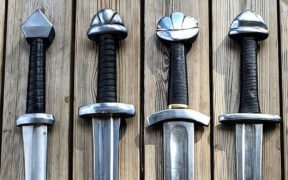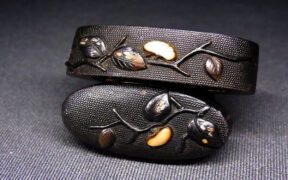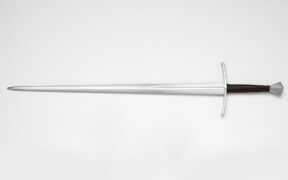Our content features commercial links to our products, committed to transparent, unbiased, and informed editorial recommendations. Learn More
The Round Pommel that defines a Ring Sword
NO AI USED This Article has been written and edited by our team with no help of the AI
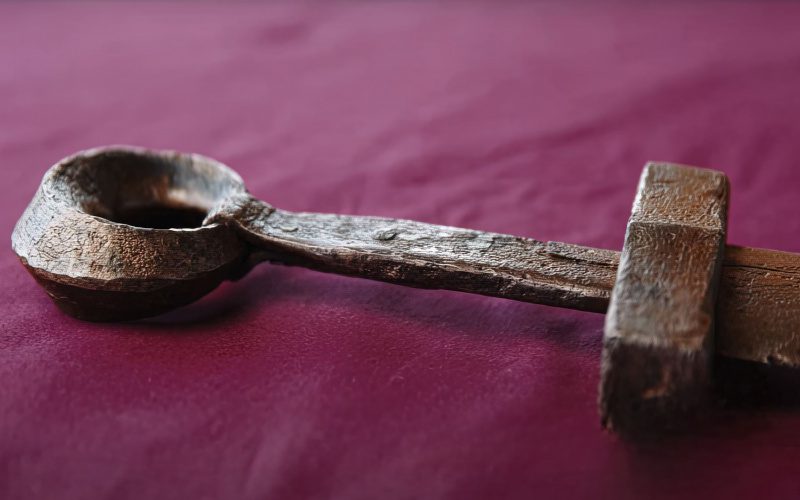
Any sword with a blade, guard, and grip that culminates in a pommel shaped like a ring is considered and called a Ring sword. Although they weren’t used all that much, the swords with ring pommels offer unique uses compared to other swords.
In this article, we shall discuss Ring Swords with their ring-type pommels, show you some examples from history, and go over their most common characteristics. Finally, you will learn about its many uses and how it compares to other pommels.
Examples of Swords with Ring Pommels
These are some examples of historical swords with distinctive ring pommels.
Irish Ring Pommel Sword
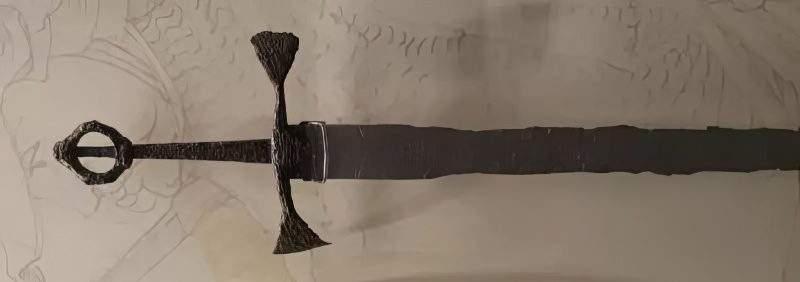
The kind of sword that was used in Ireland during the end of the sixteenth century, and seems to have been exclusive to the region, is the ring sword. These Irish swords had an open ring pommel, which most likely evolved from medieval swords with a circular or wheel pommel.
The medieval wheel pommel was a flat, circular pommel that became the most prevalent type by the 15th century. It replaced the older spherical pommel and other varieties used in the 14th century. These blades were used as weapons by the ancient Gauls and the Irish.
Korean Ring Pommel Sword

Burials from the Three Kingdoms era of Korea often have examples of the Hwandudaedo, which translates to “ring-pommel sword.” This is the first type of Korean sword. It took its title from the circular and round pommel, which was used to hold the sword.
The decorations within the ring also represented the social rank of the wearer. The presence of a dragon or phoenix, regarded as lucky beasts, gives the impression that the owner was likely a nobleman.
There are around 13 types of pommels with different animals or mythical beasts that these early Korean swords can have.
Chinese Ring Pommel Sword

Throughout the Western Han dynasty, the steel Huan Shou Dao, or “ring pommel Dao,” was heavily produced. It went on to become a devastating cavalry weapon on the battlefield.
There are many Chinese swords with a ring pommel, but the best-known example of a Chinese sword with a large ring pommel is the Dadao sword. This sword has a very broad and heavy blade that is meant to be used with slashing motions.
That is where the ring pommel comes in handy. It could be held with both hands and could easily have a rope or a tassel tied to it. When using it for downward, slashing motions, the sword could be thrown into the enemy, and the sword would stay attached to the user thanks to the ropes.
In some modern Chinese movies or anime, there are many examples of this sword being used with whirlwind strikes that can slash multiple enemies at once.
Sarmatian Ring Sword

The Sarmatians were a large group of nomadic horse-riding people from eastern Iran who ruled the Pontic grasslands and steppes from around the 3rd century BC to the 4th century AD.
Because of their horse riding, they needed a way to be able to slash and attack while mounted without needing to worry about their swords flying off. That’s why the ring pommels came into use.
The Sarmatians did use shorter ring swords like the one shown here, but they also used much larger ones too that better suited mounted warfare.
Roman Ring Sword
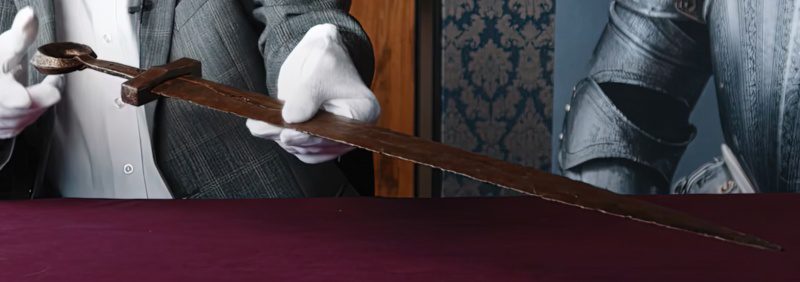
Believe it or not, ancient Roman swords utilized a ring pommel on the end of their handle, although this was rarer than other pommels. These swords were mostly dated around the 3rd century AD and weren’t widely used.
It might be confusing why and how they found their way to Rome. It’s likely that an eastern influence from the steppe nomads, the Sarmatians, had an impact on sword design in ancient Rome.
These steppe peoples were known for their cavalry warfare, which is why some Roman-mounted units adapted and began using the ring pommel. Like the other factions, they probably tied the sword to their hands when slashing to provide better grip and balance.
Early Medieval Ring Swords

There are some very rare finds of European medieval swords that have round and circular ring pommels too. The swords considered ring swords are from the migration period and shouldn’t be confused with swords with the ring pommel.
The same migration period swords and the ancient Roman ring swords probably influenced these pommels.
They could have been ordered personally by the high nobility simply because they wanted to own one. It’s also possible they were influenced by the swords from the east, with their bigger, round ring pommels.
Characteristics of a Ring Sword Pommel
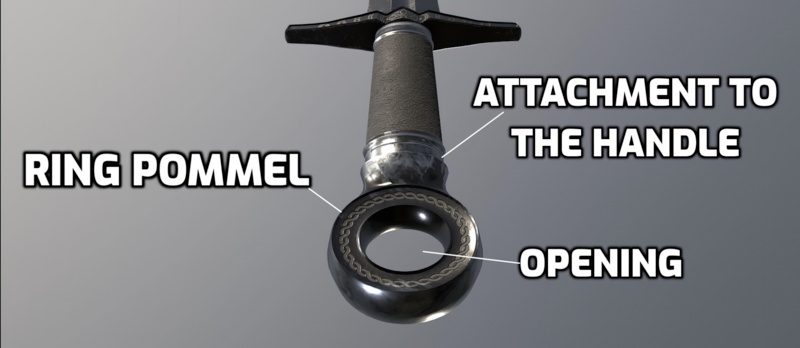
The most unique characteristic of the Ring Sword is, of course, the ring pommel.
Shape
This pommel looks like and is shaped to mirror an ordinary ring. It was made from bronze, iron, copper, silver, or steel, which was then shaped into a circle with a hole on the inside.
This ring has a small piece that extrudes from the side of the circle, which is placed inside the handle of the sword. This way, it won’t come loose when using the blade during training or battle.
Size & Length
The typical size and length of a ring pommel can vary depending on whether it’s on a short sword or a longsword. That said, the most common length found is from 1.1 to 2.1 inches (3 to 5.5 cm).
It’s made to be thin enough so that you won’t have a problem holding the handle and so it won’t touch your hand. At the same time, it’s made wide enough so that you can support the back of your hand and put something through the opening in the middle, such as a tassel or rope.
Weight
A ring pommel usually weighs around 0.3 to 0.6 lbs (150 to 300 grams). While that is the average weight, it can vary a lot depending on the material being used and the overall size.
For example, a steel silver alloy ring would be lighter than a complete steel ring pommel of the same size. Also, these ring pommels would be heavily ornate with many high-quality metals and gemstones that can contribute to the overall weight.
Uses of the Ring Pommel Sword

The reason why there is a ring on the pommel of the sword is that it increases the number of ways a soldier can use the sword.
Combat
The most prominent use for the ring sword is combat, primarily when used with a lanyard or a tassel.
Lanyard
A lanyard is a secure rope that can be attached to the inside of the ring sword and tied around it.
Once that is done, an opening in the lanyard will allow the wielder to put their hand through it and secure the sword to their wrist. This way, during combat, the chances for the sword to fly out of the user’s hand are significantly smaller. This was especially useful for cavalry warfare when attacking from above.
This lanyard is often seen in modern media, like Game of Thrones, the Hobbit, or the Lord of the Rings. Characters in these movies and shows can get extra mobility and length by throwing their sword at the enemy and pulling it back by using the rope.
Tassel
In China, a red colored tassel is often placed inside the opening of the ring sword. It is said that soldiers would use this tassel to blind the enemy when striking so that they can perform a deadly follow-up strike.
Authority & Looks
For the high nobility to differentiate themselves from other soldiers and the common folk, they often used a heavily decorated ring sword as their weapon. They would often use rare gemstones and other materials, such as silk, to decorate their weapons.
Balance
Although this hasn’t been thoroughly verified, some sword users have commented that the ring helps out with the overall balance and feel of the sword. The ring may help adjust the center of mass and weight, giving users more control over their weapons. To others, this is considered more of a personal preference and may not be an actual benefit.
Ease of Access
Sometimes just tying the sword with some rope to your belt can give you easier access. It can be unsheathed much faster than any scabbard when attached to your belt by a tassel or lanyard.
Sword Ring Pommel vs. Other Sword Pommels
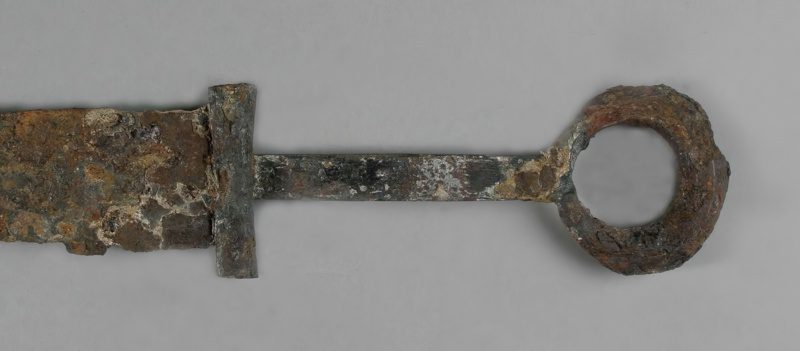
Although the ring pommel does look cool and is often used in modern media and video games like Elden Ring, in history, it wasn’t used all that much.
The biggest reason why is that a straight pommel is much more practical. For instance, if you are a foot soldier, you don’t want to worry about the opening of the ring pommel catching on somebody’s shield or possibly even your armor.
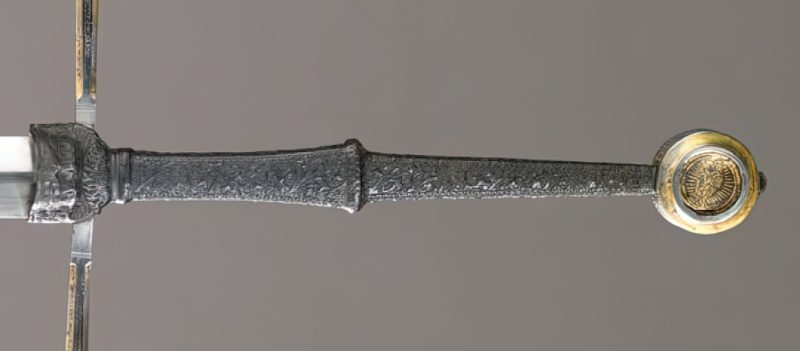
The other thing is that the straight pommel can be used for bashing somebody up close. Also, there are curved pommels, like scimitars, that offer better grip and support for the back of the hand.
Lastly, a ring pommel is more tedious to make and design en masse when compared to straight pommels, widely used by armies and soldiers.
Conclusion
The Ring swords’ unusual pommels are an exciting part of history when it comes to swords. They don’t necessarily assist the sword user, but they do add a layer of beauty and uniqueness that should please every sword fan out there.
